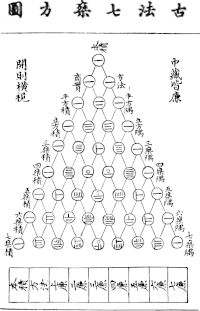Counting rods

Okay, let’s pretend you have some toys that you want to count, like blocks or cars or dolls. If you have just a few, you might be able to just look and say “one, two, three,” but what if you have a whole bunch? It would be really hard to keep track of them all just by looking!
So, a long time ago in China, they came up with a system to help people count lots of things easily. They used little sticks that were different lengths and colors, called “counting rods.” Each rod or stick represented a certain number.
The shortest stick was for the number 1, the next longest was for 2, then 3, and so on. When you needed to count something, you would use the different sticks to represent the different numbers.
For example, if you had 12 toys, you could use a long stick for 10 and two short sticks for the remaining 2 toys. Or you could use one medium-length stick for 5, two short sticks for 2, and a long stick for 10.
But the Chinese didn’t just use counting rods to count alone. They also used them to do math problems like addition and subtraction. They used the rods to visually represent the problem and then moved the rods around to solve it.
The counting rods were also used to teach kids how to read and write numbers. Since each rod had a corresponding number, kids could learn how to write the numbers by copying the rods.
So, basically, counting rods are just little sticks that people in China used to count things, do math problems, and teach numbers to kids. It was an easy way to keep track of things when you had a lot of them, and it helped people learn math and reading too!
So, a long time ago in China, they came up with a system to help people count lots of things easily. They used little sticks that were different lengths and colors, called “counting rods.” Each rod or stick represented a certain number.
The shortest stick was for the number 1, the next longest was for 2, then 3, and so on. When you needed to count something, you would use the different sticks to represent the different numbers.
For example, if you had 12 toys, you could use a long stick for 10 and two short sticks for the remaining 2 toys. Or you could use one medium-length stick for 5, two short sticks for 2, and a long stick for 10.
But the Chinese didn’t just use counting rods to count alone. They also used them to do math problems like addition and subtraction. They used the rods to visually represent the problem and then moved the rods around to solve it.
The counting rods were also used to teach kids how to read and write numbers. Since each rod had a corresponding number, kids could learn how to write the numbers by copying the rods.
So, basically, counting rods are just little sticks that people in China used to count things, do math problems, and teach numbers to kids. It was an easy way to keep track of things when you had a lot of them, and it helped people learn math and reading too!
Related topics others have asked about:
